Genre: Sports Developer: Tiertex Publisher: U.S. Gold Players: 1-4 Released: 1992
When the Leaderboard series first arrived on the golf simulation circuit in 1986, it safe to say that it took the home computer landscape by storm. The game stood for high quality in terms of presentation, gameplay and accessibility – for those qualities it was included in the book 1,001 Video Games you Must Play before you die. Needless to say, it spawned a couple of successful add-ons and sequels before Access changed the name of the game and started its highly successful Links series. The crown jewel of the series arrived in 1987. It was called World Class Leaderboard and many magazines regarded it as the pinnacle of the genre upon its release.
So with such critically acclaimed pedigree behind it, the decision was made to port the game to home consoles as well… several years later. While the excellent Master System installment was published in 1991, it took another year for the Genesis version to arrive, bringing it into direct competition with PGA Tour Golf II. So, it’s old school tradition versus the new wild and hungry generation so to speak. Nick Faldo versus Tiger Woods. Still, going into the game, my feelings were mixed. On the one hand, the earlier Master System version, as already mentioned, was excellent, maybe the best golf simulation available for the 8-bit system. On the other hand, the people behind the Genesis rendition were the programmer/publisher team-up of Tiertex and U.S. Gold – the same combo that brought us 16-bit “gems” such as Super Kickoff, Strider II, and Indiana Jones & the Last Crusade. But hey, the original they were working off was damn swell, and they also pulled off a pretty good 8-bit port, so how bad can it really be, right?
World Class Leaderboard Golf sports four different courses. Three of them – Doral Country Club (Florida), Cypress Creek (Texas), and St. Andrews (Scotland) – are fashioned after well-known real-life ones. The fourth and hardest, appropriately called Gauntlet, is an original one created for the game. The home computer edition also had a course editor that, unfortunately, wasn’t included in the Genesis version. Since I’m not much of a golf enthusiast in real life, I can’t speak for the accuracy of the original three courses. Their video game counterparts are well designed though, and they have a nice range of diversity to them that keep them apart. Other than that, you got your usual 13 clubs, including several sets of wooden and iron ones, sand wedge and putter… pretty much par for the course, so to speak.
You’ve probably already played a golf game in your life or glanced at a screenshot of one, but just as a reminder: golf courses are made up of greens, deep grass, water pits, sand traps and trees. You pick a golf club and try to take as few shots as possible to sink the ball into a hole. Holding the A button powers up your shot for the swing, and you release it at the right moment to determine its strength. After that you need to hit the A button again at the right moment for a purely hit shot. In order to ease players into the game, World Class Leaderboard Golf offers a handful of aids for beginners. Most obvious are the three difficulty settings (novice, amateur and pro), which mainly adjust the way wind affects your drives, chips, and puts. At the novice skill level, your shots also won’t drift as hard to the left or right if you don’t time your drives and chips correctly, so you’ won’t hit any hooks or slices on that setting. There’s a driving range and a putting green where you can train a bit before you enter one of the courses or an entire tournament. The courses themselves also vary in difficulty. While St. Andrews offers comparatively simple 18 holes with no water pits or trees where even novice golfers may stand a chance of winning a tournament rather easily, other tracks like Doral Country Club offer an abundance of trees and sand traps combined with doglegs that make achieving victory way more challenging. So even if access is rather easy, it’ll take quite a while until you master all courses on pro level.
Also a nice feature is the caddie. By hitting start, you can select the “Caddie Advice” option from the menu. The program then advises you which club you could take for your next shot. This usually just hints at what club would be most suitable to get as far as possible in a (relatively) straight line on the green with a perfectly powered-up shot. Caddies usually don’t advise you to shoot across obstacles in order to make a beeline for the hole. Still, it is not just a nice assistant for rookie gamers who haven’t developed a feel for proper adjustment of shots yet; on harder courses the Caddie Advice can help give you a general idea on what golfing strategy to pursue in order to get at least on par. Combined with the aforementioned skill levels and track difficulties, I feel this makes the game more accessible than the PGA Tour games on the Genesis. Putting still takes a while before you get it down quite right though, regardless of difficulty.
The presentation of the courses is nice. At the start of each hole, you get an isometric, faux-three dimensional view of the area before you get to the tee. At the lower right of the screen, you can see where your ball is in relation to other obstacles (or, in case of the putting green, in relation to the hole), and after the shot this small viewing window follows the ball across the range. While it doesn’t look as fancy as the camera view PGA Tour Golf provides, I personally prefer this way of following the ball, as it provides a slightly better feel for the course. Other areas look or feel a bit antiquated however, like the eponymous leader board or the main menus. The game also doesn’t have any kind of save feature or password system, so if you and a pal plan to play a tournament, prepare for a very long golfing session at hand.
That isn’t to say that the developers didn’t try to modernize the game. In order to properly bring this five-year-old classic into the 16-bit era, the decision was made to overhaul the graphics in order to give the game a more realistic look. The result leaves something to be desired. Trees, bushes, and the player sprite have been digitized, a decision that rarely worked out well on the Genesis. Done well, the method could still work, but that isn’t the case here. Trees and bushes are heavily blurred, and the player sprite just looks awful. Thank god it’s smaller than its PGA Tour or even the Arnold Palmer Golf counterpart, so you don’t have to look at it in too much detail. Other areas of the playing field have been drawn as simple flat, colored-in areas, which clash with the rest of the digitized design. Contrasts could have been improved as well. The green of the – well, green, clashes uncomfortably with the dark, murky look of surrounding trees and bushes. Pulled off well, the digitization could have greatly improved the atmosphere, but here it just looks muddy and blurry and is detrimental to the game’s fun factor.
Digitization also was key in the sound department. World Class Leaderboard primarily uses sound samples. While not exactly bad, they don’t excel in quality either. Chips and balls going into holes don’t sound much different in the Genesis version than they do in their Master System counterpart, which is a bit disappointing. The game also uses voice samples that comment on your play, whether you’ve landed a particularly unlucky shot (“no doubt about it, that ball is deep in the sand trap”) or successfully pulled off a really hard putt (“absolutely marvelous putt”). These samples are used sparingly, so you won’t get too bored of them, unless you get your ball stuck in the middle of some trees, in which case you’ll probably get treated by the same “looks like he hit the tree, Jim” sample over and over again. The voices were realized competently enough so that they won’t grate on your ears, though they are a bit muddy and scratchy, a far cry from top quality. Sometimes the speaker makes a few odd mistakes as well. For example, he tends to announce your ball to be “deep in the sand trap” even though it is still a few feet away from it. If you don’t want a computer voice to comment on your game, you can turn the speech off at any time.
Updating the graphics and sound engine in order to suit the game better for the 16-bit era and distinguish it from its five-year-old home computer roots was a decent idea. Its execution, however, should have been better than this. While the sounds are still okay for an early nineties golf game, the attempt of making the game look more realistic by using digitized graphics failed. Too bad, because the blurry results detract from an otherwise solid, if a bit antiquated, gameplay mechanic. The course design is good, and a variety on gameplay modes, difficulty settings, and optional help like the “Caddy Advice” feature make the game very accessible for beginners while remaining challenging for more experienced players. The four courses provide a solid range of diversity, even though the direct competitor PGA Tour II could already offer seven at the time. With better, sharper graphics this could have been a top contender. If you don’t mind blurry trees and bushes and your golfer looking like a weird jumble of pixels, and if you’re looking for a golf game that allows you to ease into the genre, then this could be the 16-bit golf game for you.
SCORE: 6 out of 10

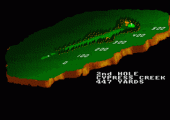
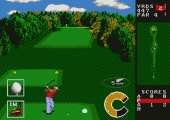
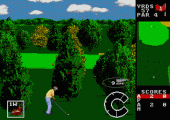
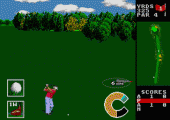
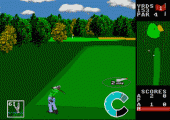
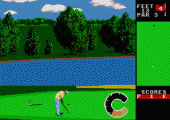
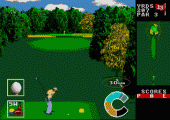
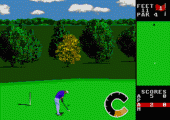
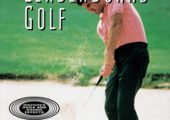
I haven’t seen this Game before, but it looks funny.